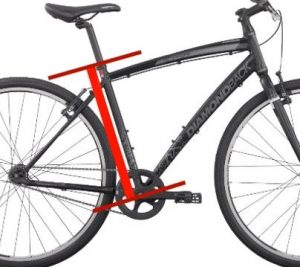With the Defeat of Jesse James Days upon us, the annual bike tour put on by the Northfield Rotary will take place on Saturday. Hundreds attend this bike event annually. Whether you’re an avid bike enthusiast or planning on putting your feet to the pedals for the first time, you’re welcome to participate. But, how do you know what bike fits you? We see bike injuries from falls and crashes regularly, but we also see overuse injuries to the hips, knees, ankles, arms, and neck as well. So, what bike should you be riding?
Luckily, Northfield has AMAZING retail owners that can fit you perfectly for your body and style/use expectancy.
If you don’t have that information, here are a few tips:
-
Should I be riding a men’s or women’s bike? Seems simple enough, right? However, some men’s bodies may be more suitable for a women’s bike and some women’s bodies may be more suitable for a men’s bike. Typically, men’s bikes are made for a longer torso, shorter leg body type. While women’s bikes are made for a shorter torso, longer leg body type. So, if you’re a male, riding a male bike, and feel like you’re over extending your neck and arms, you may actually fit a women’s bike better. A simple measurement will let you know a basic fit. Divide your total height by your inseam (just a ratio, so you can use cm or inches). If the ratio is 2.2 or larger, you would be fit for a men’s bike. If the ratio is 2.0 or smaller, you would be fit for a women’s bike. If you’re in-between, you’re in trouble if you’re indecisive because you could use either.
-
The bikes are listed as 26 inches, 30 inches, but what does that mean? There are many different ways to measure a bike. Typically a bike is measured from the center of the pedal spoke to the top of where the seat attaches to the bike (pictured below). Depending on your type of bike, there are many different ways to measure, but a basic calculation is as follows:
Touring/hybrid/commuter bikes: Leg inseam (cm) X 0.685
Mountain bike: Leg inseam (cm) X 0.66
Road bike: Leg inseam (cm) X 0.7
Inseam is measured from your groin to the floor. While some references state to be barefoot, I would recommend wearing the shoes you would typically wear while biking to measure your inseam. To change to inches, divide by 2.54. There are charts that show your full height and what that would mean for size, but then you may lose the ratio aspect of torso vs leg length.

-
How high should my seat be? You don’t want to over or under extend your legs while riding to avoid injuries. To know how high you should raise your seat, sit on the seat and have your foot on the pedal in the 6 o’clock position with the ball of your foot on the pedal. In this position you should have a 250 – 300 bend in the knee. Remember to keep your leg as parallel to the bike as possible (you don’t want your knees to point outward or toward the frame of the bike while you ride). Another simple way would be to sit on the bike with the right pedal in the 3 o’clock position. Hold a string from your right knee (just behind the knee cap) and let it form a plumb line to the ground. The string should pass through the pedal of the bike.
-
How high should my handle bars be? If your handle bars are too low, you will have to overextend your neck see ahead of you. However, with your handle bars lower, you will also be the most aerodynamic for speed biking. So, many road bikers will set their handle bars approximately 1.5 inches or more below their seats. The lower the handle bars, the less comfortable the ride. Touring bikers will often have the handle bars more even with the seat, while mountain bikers will have the handle bars higher than the seat. So, depending on what you plan to do with your bike and your comfort, the handle bars can be adjusted.
For a personal fit on a bike, I would suggest talking to a local bike shop owner, like Downtown Bicycles in Northfield. Knowing that there are many ways to measure bikes, there may be differences in the above calculations from different bike experts. So, if you’re riding is uncomfortable, there may be changes to be made. Keep in mind that previous disc injuries and back pain sufferers may be more comfortable being more upright and have less impact using more forgiving tires. And, with winter coming, now’s your chance to try out the fat tire bikes.
Is Chiropractic Care Right for You?
Chiropractic is effective in treating many conditions such as back pain, neck pain, headaches, and so much more!
